Prince Edward Island's provincial symbols
One of Canada’s three Maritime Provinces, Prince Edward Island is the smallest province in both land area and population.
Origin of the name
The province's name was adopted in 1799 to honour Prince Edward, Duke of Kent. He was the fourth son of King George III and the father of Queen Victoria. Prince Edward was commander-in-chief of British North America and was stationed in Halifax when the island was named.
Aboriginal peoples called Prince Edward Island “Abegweit”, derived from a Mi’kmaq word loosely translated as “cradled in the waves”. Early French settlers called it “Île St-Jean” and when the Treaty of Paris in 1763 gave the island to the British, the name was translated to St. John Island.
The island also has several nicknames including the “Million- Acre-Farm” and the “Garden of the Gulf”.
Population (2006):138,500
Area: Land – 5,660 km2Fresh water – 0 km2Total – 5,660 km2Capital: CharlottetownDate of entry into Confederation: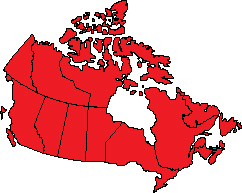
History
Although the Mi’kmaq have inhabited the island for the last 2,000 years, there are indications that their ancestors lived there as long as 10,000 years ago. These Aboriginal peoples are said to have reached the island by crossing the low plain now covered by the Northumberland Strait.
In 1534, Jacques Cartier was the first European to set eyes on the island, which he called the fairest land that may possibly be seen. Despite Cartier’s glowing description, settlement of the island was slow. Not until the early 1700s did the French establish a permanent colony and, by 1748, the population was still fewer than 700.
The population of the island grew dramatically following the British expulsion of the Acadians from Nova Scotia in 1755. By the time the French Fortress of Louisbourg fell to the British in 1758, the population of the island was more than 5,000. The British forced all but a few hundred of the Acadians to leave the island, even though France did not sign over the island until the Treaty of Paris in 1763.
In 1758, the island became part of the British colony of Nova Scotia, which at that time also included the present-day province of New Brunswick. In 1769, the island became a separate colony.
Prince Edward Island was plagued throughout most of the colonial period with problems of absentee landowners. Most of the people granted land by the British Crown never set foot on the island. Some refused to sell land to the tenants; others charged outrageous prices to sell, or demanded high rents of those who wished to establish farms on the rich land.
The island’s government tried to impose a tax on landowners to cover the cost of administration, but this tax was next to impossible to collect. In 1840, the colony was able to buy land from some of the landlords and make it available for purchase by tenants. However, money for this purpose was soon exhausted.
Prince Edward Island hosted the first of the Confederation conferences at Charlottetown in 1864. However, the island’s leaders dropped out of the discussions after the Québec Conference later the same year; they feared the island’s autonomy would be jeopardized by joining a large Canadian union.
Less than ten years later, that decision was reversed. The debt incurred in building a railway for the island, pressure from the British government, and the attractive promises of the Canadian government compelled Prince Edward Island to join Confederation in 1873. The Canadian promises included an absorption of the debt, year-round communication with the mainland and funds to buy out the absentee landowners.
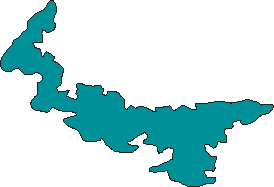
Coat of arms
Prince Edward Island’s coat of arms, which is based on the design of the provincial great seal first used in 1769, was granted officially by King Edward VII in 1905. In 2002, a crest, supporters, compartment, and the province’s traditional motto were granted by the Right Honourable Adrienne Clarkson, Governor General of Canada.
The top part of the shield features the English heraldic lion, which appears on the coat of arms of Prince Edward, after whom the province is named, and on the royal coat of arms of King Edward VII, who assigned the provincial arms. The lower part of the shield shows a green island with a large oak tree on the right and three young oaks on the left. The mature tree represents the Oak of England, while the tree saplings represent the province’s three counties — Kings, Queens and Prince. The trees rise from a single base, as both Britain and Prince Edward Island are islands.
The crest combines the blue jay and the red oak leaf – two provincial emblems – with the Royal Crown, all placed on the gold helmet of sovereignty signifying Prince Edward Island’s co-sovereign status in Confederation. The supporters are two silver foxes, prized local animals that indicate the importance of fur farming in the 19th and early 20th century economy of the province. Around their necks are a garland of potato blossoms and a length of fishing net, representing the agricultural and fishing industries. The compartment on which they stand includes the rose, lily, shamrock and thistle emblems of England, France, Ireland and Scotland, along with two lady slipper flowers, the provincial floral emblem. At the centre is an eight-pointed star, a symbol used for centuries by the Mi’kmaq people to represent the sun.
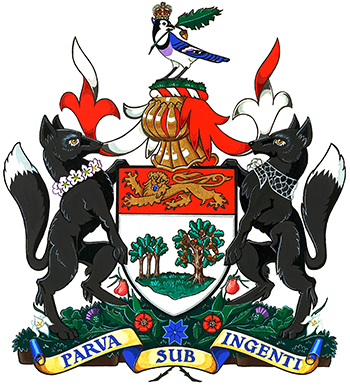
Motto
Parva sub ingenti (The small under the protection of the great)
Flag
Prince Edward Island’s flag was granted royal warrant of King Edward VII in 1905 and was officially assented to in 1964 by an act of the legislature. The flag is modelled after the coat of arms in rectangular shape and is bordered on the three sides away from the mast by alternate bands of red and white. The flag’s proportions are three by length and two by width.

Floral emblem
Prince Edward Island’s floral emblem, the lady’s slipper (Cypripedium acaule) was adopted in 1947. A species of orchid, it takes its name from the shape of its petals, which form a pouch somewhat like a slipper. Bees tumble into the pouch and, in their efforts to scramble out, brush against the male and female flower parts, thus pollinating the flowers. The lady’s slipper grows in shady and moist woodlands and blooms in late May and June.
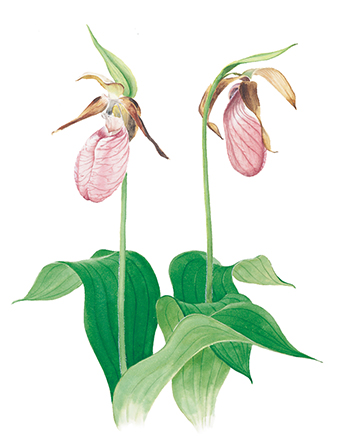
Other provincial symbols
Bird
The blue jay (Cyanocitta cristata) was officially adopted as Prince Edward Island’s provincial bird in 1977 following a province-wide vote.
Found throughout the province year round, the blue-hooded, black-winged bird prepares for winter by gathering and storing grains, seeds and suet.
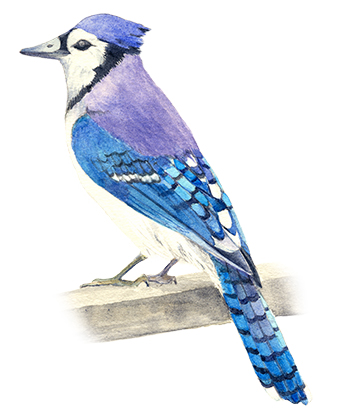
Provincial soil
In 1997, Prince Edward Island adopted the Charlottetown soil series in recognition of the province’s greatest natural resource – the land.
As the most predominant soil in Prince Edward Island, Charlottetown soil accounts for roughly 470,000 acres of land. Characterized by a fine sandy loam texture, it is considered the best soil for the production of a wide range of crops, including one of the island’s most famous commodities – the potato.
The island is formed from sedimentary bed rock of soft, red sandstone that produces the rich, red soil. The redness of the soil is due to the high iron-oxide (rust) content.
Tartan
Designed by Mrs. Jean Reid of Covehead, the Prince Edward Island tartan was adopted after a province-wide contest in 1960. The reddish-brown signifies the redness of the soil; the green represents the grass and trees; the white is for the caps on the waves; the yellow for the sun.

Tree
The red oak (Quercus rubra) was adopted as Prince Edward Island’s official tree in 1905.
Found throughout the province during the early years of European settlement, the red oak’s fine-grained wood was highly sought after by furniture makers who milled the tree to practical extinction on the Island. The province has since created the Royalty Oaks Natural Area in Charlottetown as a reserve for these majestic trees.


Page details
- Date modified: